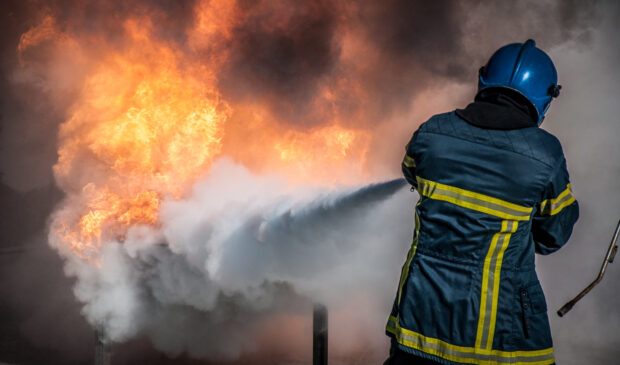Council urges cutting PFAS from firefighting equipment
Friday, September 13, 2024 by
Jo Clifton On a unanimous vote Thursday, City Council adopted a resolution urging the city’s Fire Department to eliminate PFAS (per- and poly-fluoroalkyl substances) from the city’s firefighting equipment, noting that the substance is dangerous not only to firefighters but also to the environment. Council Member Mackenzie Kelly was the lead sponsor of the resolution.
As the resolution notes, PFAS are a group of chemicals used in a variety of industrial and consumer products, including firefighting equipment. That equipment includes the foam sprayed on fires to suppress flames, as well as the gear firefighters wear to fight fires. They are frequently called “forever chemicals” because of their persistence in the environment.
Kelly is a volunteer firefighter with the Jollyville Fire Department, where she said she has “seen far too many firefighters who have passed as a result of presumptive cancer.” She added, “I think it is important as a city that we are good stewards of our employees,” which she said includes doing everything they can to reduce the impacts of firefighting on individuals who are working to save lives.
Firefighters are already at increased risk of cancer because they are exposed to a variety of hazardous substances on the job. Under Kelly’s resolution, the city manager has been directed to develop and implement a plan to phase out firefighting equipment that contains PFAS. Initially, the resolution called for the complete removal of PFAS materials within three years. However, Kelly told the Austin Monitor that such a short timetable might not be practical because of the limited availability of gear and foam that does not contain the dangerous chemical. In addition, she said, AFD will have to test any new gear before the department can adopt it.
The resolution was co-sponsored by Council members Alison Alter, Ryan Alter, Natasha Harper-Madison and Chito Vela.
Bob Nicks, a retired firefighter who serves as president of the Austin Firefighters Association, told the Monitor the department has already done quite a lot to get new foam and gear that does not contain PFAS. In fact, Nicks said the department was already in the process of trading out its old PFAS-laden foam for foam that does not include those chemicals at the Austin airport. He explained that they will be able to use their current equipment to spray the foam on a fire but that they will need more of the new foam to suppress a fire than what they have used in the past.
The firefighters association has started a cancer prevention committee to study the problem of cancer among Austin firefighters. In a letter to Council, Nicks said the committee would work on a plan for cancer prevention measures as well as early detection and establish a program to support firefighters undergoing cancer treatment.
The problem with PFAS is that they are extremely widespread, he noted.
“It’s in our environment, in our water tables, and it’s in just about everybody’s blood, but it’s higher in the blood of firefighters.” He added, “We know that PFAS chemicals can create liver damage and elevate cholesterol. It can also cause cognitive decline.” He said the association wants to test all firefighters to see what level of PFAS they have in their blood. When the firefighters get the information about their level of PFAS chemicals, Nicks said they would share that information with the city’s Environmental Commission.
At least 15 states have already banned the use of PFAS in firefighting foam. In addition, the International Association of Fire Fighters has called for a ban on the manufacture and use of PFAS in firefighting foam and equipment.
Firefighters are certainly not the only ones who are threatened by PFAS. Environmental activist Craig Nazor told Council that the Sierra Club supported the resolution and warned, “When you have a fire and you spray PFAS” on the burning materials, all of that material “goes to our landfills. There’s going to be a reckoning coming soon about the PFAS in our landfills. There already has been a lot of research into this and sooner or later someone’s going to be charged” for the cost of “trying to clean all those landfills filled with PFAS.” He concluded it was “a really important issue for the city to get involved in so we can avoid those costs.”
Kelly said after she heard Nazor’s comments she immediately decided that she needed to talk to Austin Resource Recovery. Her aide said she has already made that appointment.
Photo made available through a Creative Commons license.
The Austin Monitor’s work is made possible by donations from the community. Though our reporting covers donors from time to time, we are careful to keep business and editorial efforts separate while maintaining transparency. A complete list of donors is available here, and our code of ethics is explained here.
You're a community leader
And we’re honored you look to us for serious, in-depth news. You know a strong community needs local and dedicated watchdog reporting. We’re here for you and that won’t change. Now will you take the powerful next step and support our nonprofit news organization?


